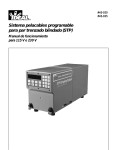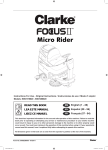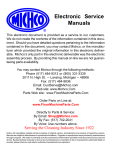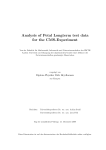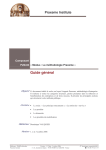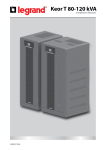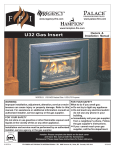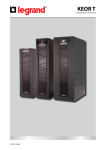Download IDEAL INDUSTRIES 45-930 User's Manual
Transcript
#45-930 #45-935 Shielded Twisted Pair (STP) Cable Stripping System For 115V or 230V Operation Manual Shielded Twisted Pair (STP) Cable Stripping System Table of Contents Introduction ..................................................................... Caution and Safety Instructions ....................................... Environmental Conditions ............................................... Warranty & Service Policy ............................................... Unpacking........................................................................ STP Service Setup ........................................................... Electrical Connection Requirements ............................... Air Connection Requirements .......................................... System Controls .............................................................. Heat Adjustment ......................................................... Thermal Head Rotation Speed Adjustment.................. Pull Grip Pressure Adjustment ................................... Strip Length Adjustment............................................. STP Operation Head Adjustment ........................................................ Thermal head Rotation Speed Adjustment .................. Pull Grip Pressure Adjustment ................................... Strip length Adjustment.............................................. Cycle Mode ................................................................ Slug Removal ............................................................ 2 3 3 3 3 3 4 4 4 4 5 5 5 6 6 6 7 7 8 Program Mode................................................................. 9 Set Mode .........................................................................10 STP Service .....................................................................11 Batching...........................................................................11 Recommended Spare Parts ..............................................12 Parts Replacement Gripper Pad Replacement ...........................................13 Front Gripper Pad Replacement..................................13 Rear Gripper Pad Replacement ...................................14 Tension Springs .........................................................14 Blade Replacement ...............................................15-16 CPU Module Replacement..........................................17 Power Module Replacement .......................................17 Maintenance ....................................................................18 Changing Slug Tray Location ..........................................18 Trouble Shooting .............................................................18 Machine Schematic & Parts List ................................19-21 Electrical Schematic.........................................................22 Introduction The IDEAL Shielded Twisted Pair Cable Stripping System (STP) is a programmable bench top machine that accurately removes the outside jacket from shielded twisted pair cable. The STP addresses occupational ergonomic needs by offering an alternative to manual stripping methods which are known to have contributed to cumulative tissue trauma. The STP system automatically adjusts to the size of the cable being stripped up to a maximum diameter of 0.3125 inches. Cable strip length is programmable by inches or millimeters. The strip length is adjusted in preset increments from a minimum of 1-1/4 inches to a maximum of 6.00 inches. A strip operation cycle can be completed in as little as five seconds. The large, easy-to-read display shows the operating function status and facilitates program entry. A memory module stores up to 500 user defined “batch” programs and incorporates a battery back-up system. A service machine message can be programmed for display when the machine completes a preset amount of operations. All operating parameters can be secured from unauthorized modifications by a programmable security code. The intuitive front panel keypad provides tactile feedback and is highly resistant to harsh industrial environments. The STP stripping system consistently produces quality levels achieved in the aerospace industry. With its wide array of powerful features, the IDEAL STP is extremely flexible, simple to program and easy to use. 2 Caution and Safety Instructions Please read, understand and follow the warnings and instructions in this manual. Failure to do so can result in serious personal injury. • Do not alter, modify or misuse the machine. • Do not operate the machine using an ungrounded electrical system. • Do not perform any maintenance on the machine unless both the electrical power and air supply are disconnected. • Do not operate the machine in a damp, wet, gaseous, hazardous or poorly ventilated work environment. • Do not obstruct any ventilation or air flow around the machine. CAUTION – Hazardous parts inside, refer servicing to qualified service personnel. CAUTION – Blade area can create high temperatures; refer servicing to qualified service personnel. CAUTION – Use proper heavy lifting procedures. Environmental Conditions Indoor use only Altitude up to 2,000m Temperature 5°C to 40°C Maximum relative humidity 80% for temperatures up to 31° decreasing linearly to 50% humidity at 40°C Mains voltage fluctuations not to exceed±10% of normal voltage Insulation Category II Pollution degree 2 Unit can produce sound levels greater than 85 dB, proper hearing protection is required. Warranty & Service Policy Each unit is warranted to be free from defects in materials and workmanship under normal use and service for a period of 12 months after the date of purchase. The obligations of IDEAL under this warranty shall be limited to repairing at the Sycamore, Illinois manufacturing facility any unit which shall, within the 12 month period, be returned to us with the transportation charges prepaid, and with our examination shall disclosed to our satisfaction to have been defective. This warranty shall not aply to any model which has been altered or repaired outside the factory in any way so as to affect its operation nor which has been subject to misuse, negligence, accident or installed or operated in any other way than in accordance with our instructions, nor shall this warranty extend to repairs or replacement made necessary by the use of accessories not recommended by IDEAL. Unpacking The IDEAL Shielded Twisted Pair (STP) Cable Stripping System is shipped in protective foam packaging. You may wish to save this packaging for future transportation. Description Cat. No. STP, 115 VAC, 60 Hz 4A STP, 230 VAC, 50 Hz 2A Power Cord T®-Cutter Lite Air Hose Slug Tray Air Regulator Operation Manual Security keys IDEAL Key Chain 45-930 45-935 K-6773 45-260 K-6865 IA-3124 45-906 ND-3514 1301.012 99-020 The STP unit is equipped with a power cord, air hose, slug tray, IDEAL T®-Cutter Lite wire cutter, keys, key chain, air regulator kit and an operation manual. Lifting Instructions for the STP Locate the front and rear of the machine. The front of the machine has the keypad and display. Position the machine so the front of the machine is pointing to your left and the rear of the machine is to your right. Also position the machine as close to your body as possible. Place your left hand underneath the bottom plate and center it between the two front rubber feet. Place your right hand underneath the bottom plate and center it between the two rear rubber feet. Pull the machine up and toward your body. When carrying the STP, always keep the machine as close to your body as possible. Note: Where ever possible, lift with your legs slightly bent and your back straight (vertical). Lift the load by straightening your legs not by pulling up with your arms. STP Service Setup (Qualified Service Personnel) The STP front cover is secured with two (2) screws for shipping. Remove the screws from lower right and left sides of cover before opening lid. Gripper pad pins are secured with plates for shipping. Remove these plates from both front and rear gripper pad housings before machine use. NOTE: Do not invert the unit after shipping plates have been removed. Gripper retaining pins will fall out when inverted. Close cover and replace screws removed. Install slug tray - Insert the long screws provided, tighten. Rear Front 3 STP Service Setup Continued Electrical Connection Requirements Voltage Selection The STP operates on either 115V/230V AC; 45-930, 115V AC 4A 60 Hz ; 45-935, 230V AC 2A 50 Hz. Proper voltage will be preset at the factory. Fuse Replacement Disconnect power cord and remove the fuse cartridge using a small blade screwdriver or similar tool. Replace two fuses with recommended fuses. 45-930, 4AT 250V, 1/4” x 1-1/4”; 45-935, 2AT 250V, 5 mm x 20 mm, insert the fuse cartridge back into the unit making certain the proper voltage is selected. On-Off Switch — Located on the back of the unit, the on/off switch controls the main electrical power supply. Air Connection Requirements Connect 1/4" coiled air hose to the air inlet fitting located on the back of the unit. This is a reusable compression type fitting. To connect air hose: 1. Disconnect electrical power supply. 2. Connect the air hose by inserting it firmly into compression fitting. Air must be clean, dry and pressure regulated to 100 PSI. The STP consumes approximately 50 cubic inches (about .03 cubic feet) of compressed air per cycle. Total air volume consumed depends on frequency of operation. To disconnect air hose; 1. Disconnect electrical power supply. 2. Disconnect air supply. 3. Depress the red ring and pull on the air hose. STP Operating Principles and Terms The following section describes the basic principles of operation of the 45-930, STP. The STP uses a combination of four variables to perform each strip. It is important to understand each of these four control parameters and how they interrelate to obtain the desired stripping results. The four variables are HEAT, SPEED, PRESSURE and STRIP LENGTH. Each variable is described in terms of settings, ranges and effects on stripping. The individual variable settings may affect the other variables and the final stripping results. Please refer to the “Electrical Controls” section for instructions on how to regulate each setting via the control panel. HEA T SPEED PRES SURE STRIP LENG TH PRGM. COUNT HIGH CLEAR BA TCH ENTER HEAT: Thermal Blade The HEAT setting controls the level of power (heat) directed to the blades during the thermal cutting phase of the stripping cycle, with 10% being lowest heat and 100% highest. The STP may also be operated with a heat setting of 0%, which runs the unit through a complete cycle without using the blades. This is intended to pull off a slug that has already been cut either by the STP or manual methods. Since the STP is a thermal stripper, heat plays a very important role in the stripping process. Insulation materials have a wide variety of melting temperatures, requiring the STP to produce a full range of blade HEAT settings. The melting temperature of an insulation material, high or low, must be consistently matched by the STP blade heat setting for a successful stripping operation. Another important factor is the rate at which the blade heat penetrates the insulation material. A tendency may be to strip at the highest blade heat available. This produces two undesirable results. First, the higher blade HEAT setting is inversely proportional to blade life. Second, the blade may displace the insulation material too quickly, producing an excessive amount of contact with the inner shield. For these reasons it is important to correlate the blade HEAT setting with the blade rotation SPEED setting. 4 STP Operating Principles and Terms (continued) SPEED: Thermal Head Rotation SPEED refers to the rate of rotation by the Thermal Head of the STP. This is the rate at which the blades are rotated about the wire being stripped. The slowest speed is 1 and 10 the highest. Running at a faster speed requires a higher blade heat setting which may shorten the blade life. A superior strip quality is obtained at lower blade HEAT and SPEED settings. However, the various types and thicknesses of insulation material requires a wide variety of HEAT and SPEED setting combinations (to avoid touching the inner braid). PRESSURE: Rear Grip Mechanism The PRESSURE setting regulates the air pressure delivered to the internal, rear grip mechanism. This mechanism is used to pull the stripped slug off the wire. Based on a line pressure of 100 PSI, which is required for operation of the unit, the internal rear grip can be set to operate from 5 PSI to 100 PSI in increments of 5 PSI. Various insulation materials and shield types require varying grip pressures to obtain optimal slug removal results. The rest of the machine runs on a constant 100 PSI line pressure. Having air pressure controlled electronically allows the STP to use a variable amount of grip force to hold the insulation slug while trying to pull off the slug. This is important for three reasons. First, various materials adhere to the braid differently and require more or less grip pressure to be pulled from the shield. Excessive grip pressure increases internal friction between the slug and shield, preventing removal of the slug. Second, different materials have varying coefficients of friction with the grip pads. This creates the need for a wide variety of grip PRESSURE settings. Finally, the strip length affects the amount of grip pressure required. STRIP LENGTH The strip length range of the STP is from 1.25 to 6.00 inches (31 to 150 mm). It can be set in increments of .01 in. or 1 mm. The strip length required for a given wire is a user-defined variable. Longer or shorter strip lengths may require varying grip PRESSURE settings. Once the STP is set to strip 3.00 inches or longer the grip PRESSURE setting remains fairly constant for a given wire type. However, when stripping less than 3.00 inches it may be necessary to increase the grip PRESSURE setting. This is due to the fact that the internal, rear grip mechanism is about 4.00 inches long and consists of separate pressure points. When less than 3.00 inches is to be removed, the grip mechanism is not fully utilized and may require a higher PRESSURE setting to accomplish the task. Any given wire may be successfully stripped over a range of setting combinations. It is important to look at all of the variables and resulting performances in order to select the combination that best suits the specific stripping requirements. IDEAL INDUSTRIES, INC. offers free application assistance... for immediate assistance, call our technical service hotline at 1-800-338-4495. STP Operation When the machine is turned on, the software version is briefly displayed followed by the machine initializing. Example: Ready Mode Display Then the Machine Status display appears showing the present settings. During operation there are three different status displays: READY MODE, “ENTER VALUE” (a value is being entered or the machine is adjusting to a new value) and “CYCLE IN PROGRESS” (the machine is in a strip cycle). At this point, you can proceed stripping wire, enter new values or retrieve a preset batch with different settings. Use the following procedures to change the machine settings via the control panel keeping in mind the “Operating Principles and Terms” described on page 4, while selecting process variables. HEA T SPEED PRES SURE STRIP LENG TH PRGM. COUNT HIGH CLEAR BA TCH ENTER All control settings can be set by either using the arrow keys or setting discrete values on numeric key pad. 5 STP Operation continued Heat Adjustment Heat can be adjusted by pressing [0] through [9] producing corresponding heat values of 0% through 90%. Pressing HIGH sets the heat at 100%. If the heat is set at 0%, the machine completes the cycle without using the blades. The heat can also be adjusted by pressing HEAT and using the [ ↑ ] and [ ] keys. The heat is adjusted from 0% to 100% in increments of 10%. Pressing the ENTER key exits from the heat entry mode and returns to the ready mode. ↑ If CLEAR is pressed during a HEAT entry, it returns to the beginning of the HEAT entry mode. If CLEAR is pressed at the beginning of the HEAT entry mode, it exits the HEAT entry mode and the previous settings are returned. Example 1 HEAT 20% 10 40 3.10 ENTER VALUE Press Example 2 ENTER Press HEAT Field will Flash HEAT 20% 10 40 3.10 PRGM. HIGH ENTER VALUE or Press Press Or Press for 100% Heat HEAT Field will Flash Press To Enter Single Digit Value BA TC H ENTER Thermal Head Rotation Speed Adjustment Speed can be adjusted by pressing [1] through [9] corresponding to speeds 1 through 9, and pressing HIGH for speed 10.The speed at which the thermal blades rotate around the wire being stripped can also be adjusted by pressing SPEED and using the [ ↑ ] and [ ] keys. The speed is set from 1 to 10, the fastest setting being 10. Pressing the ENTER key exits from the speed adjustment mode and returns to the run mode. ↑ If CLEAR is pressed during a SPEED entry, it returns to the beginning of the SPEED entry mode. If CLEAR is pressed at the beginning of the SPEED entry mode, it exits the SPEED entry mode and the previous settings are returned. Example 1 SPEED 20% 10 40 Example 2 3.10 ENTER SPEED 20% 10 40 3.10 PRGM. HIGH ENTER VA LU E ENTER VA LU E Press Press or Press Press Or Press for Speed 10 SPEED Field will Flash SPEED Field will Flash Press To Enter Single Digit Value BA TC H ENTER Pull Grip Pressure Adjustment Pressure can be adjusted by pressing the numbers corresponding to pressures 05% through 95%, pressing HIGH sets the pressure at 100%. EXAMPLE: press [4] then [5] to get pressure at 45%. The pressure can also be adjusted by pressing PRESSURE and using the [ ↑ ] and [ ] keys. Pressure can be adjusted from 5 to 100 PSI in increments of 5 PSI. Pressing the ENTER key exits from the pressure entry mode and returns to the ready mode. ↑ If CLEAR is pressed during a PRESSURE entry, the display returns to the beginning of the PRESSURE entry mode. If CLEAR is pressed at the beginning of the PRESSURE entry mode, the display exits the PRESSURE entry mode and the previous settings are returned. Example 1 PRESSURE 20% 10 40 Example 2 3.10 ENTER VALUE Press PRESSURE Field will Flash ENTER Press PRESSURE 20% 10 45 3.10 HIGH or Press Press Or Press for 100% Pressure PRESSURE Field will Flash Press To Enter Single Digit Value 6 PRGM. ENTER VALUE BA TC H ENTER STP Operation continued Strip Length Adjustment, by Discrete Value For Example Enter Value of 75 mm: METRIC LENGTH MODE (31 mm to 152 mm) • Press STRIP LENGTH. • The strip length display will blink. • Enter the strip length and then press ENTER. A strip length is automatically entered after a third digit is pressed. 20% 10 STRIP LENGTH ENTER 40 0 ENTER VALUE Press Press Numbers 7 Then 5 Digit Will Blink Press ENGLISH LENGTH MODE (1-1/4 inches to 6.00 inches) • Press STRIP LENGTH. • The first digit will blink. Press the appropriate number key and it will be entered. • Press the decimal point. • The tenths digit will blink, press the appropriate number key. • Next the hundredth position will blink, press the appropriate number key. • After typing the hundredth position, the new strip length is set. If at any time during the strip length entry ENTER is pressed, the current strip length will be set. If CLEAR is pressed during a strip length entry, it returns to the beginning of the strip length entry mode. If CLEAR is pressed at the beginning of the strip length entry mode, it exits the strip length entry mode and the previous settings are returned. For Example Enter Value 3.25 Inches: STRIP LENGTH 20% 10 ENTER 40 0.00 BATCH VALUE Press 20% 10 40 20% 10 3.00 Press 3 Press 3.20 Press 2 Second Digit Will Blink First Digit Will Blink 40 ENTER VALUE ENTER VALUE Press 5 Third Digit Will Blink Strip Length Adjustment By Increment While in the ready mode, the strip length can be changed up or down by increments using the [ ↑ ] and [ ] keys. Programming the increment is explained in the Set section of Program. ↑ In either of the strip length entry methods, the strip length is checked. If the strip length is invalid, an appropriate message appears and the previous strip length is displayed. Cycle Mode NORMAL STRIP CYCLE • To select a new cycle mode, press Program/High Press • Enter in the 3-digit security code Note: All units are factory preset to a 3-digit security code of “111.” To make any changes in the Program Mode the security code must be entered. PRGM. HIGH • The display will show 1 - Test 2 - Set 3 - Mode Clear_Esc • • • • • • Select [3] for Mode Select [1] NORMAL CYCLE MODE Press count/clear on your key pad Self Check - Press enter and hold to display batch number and selected cycle mode. Insert wire for normal cycle mode Remove wire when cycle is completed 7 STP Operation continued TWO STAGE CYCLE The TWO STAGE CYCLE is intended to break the STP’s stripping cycle into two separate stages; stage one is for cutting, stage two is removal. When the cable is inserted, the first stage will thermally cut the insulation. When this stage is completed and the cable is removed, the cable can be inspected for a complete cut, or the cable can be flexed to insure a complete cut has been achieved. When the cable is re-inserted into the STP, the slug is removed thus completing stage two. Some insulations will require all material to be separated prior to the removal stage. Between the two stages the display will show that the cable must be re-inserted to complete the cycle or the cycle may be terminated by pressing clear. • To select a new cycle mode Press PROGRAM/HIGH Enter in the 3-digit security code Note: All units are factory preset to a 3-digit security code of “111.” To make any changes in the Program Mode the security code must be entered. • The display will show ENTER IN 3-DIGIT 1 - Test 2 - Set SECURITY CODE — 3 - Mode Clear_Esc Press • Press [3] for mode • The display will show [1] - Normal [2] - Two Stage [3] - Double Cut Select [2] for Two Stage Mode • Self Check - Press enter and hold to display batch number and selected cycle mode. • Insert wire into wire port. Note: This stage will cut only the outer insulation. • Remove cable from unit, inspect and possibly flex to insure all material has been separated to complete the cut. • Re-insert wire into port to complete second stage. Note: Slug is removed in this stage. • Remove wire from port. PRGM. HIGH DOUBLE CUT CYCLE The DOUBLE CUT CYCLE is designed to make two cuts in the jacket and then remove the outer most slug while leaving the inner most slug in place to protect the braid. The length of the inner slug can be selected. The total of the two slug sections is equal to the overall strip length value. • To select a new cycle mode ENTER IN 3-DIGIT Press PROGRAM/HIGH SECURITY CODE — Press Enter in the 3-digit security code Note: All units are factory preset to a 3-digit security code of “111.” To make any changes in the Program Mode the security code must be entered. • The display will show 1 - Test 2 - Set 3 - Mode Clear_Esc • Press [3] for Mode • The display will show [1] - Normal [2] - Two Stage [3] - Double Cut Select [3] for Double Cut • Set Slug length for Double Cut 0.00 in. - The tenths digit will be blinking, when this value is entered, the hundredths place will blink. After the hundredths place is entered the value is automatically entered. Due to the nature of the double cut cycle, some combinations of strip lengths and slug lengths cannot be performed. • Press Count/Clear on your key pad • Self Check - Press enter and hold to display batch number and selected cycle mode. Note: Slug length too long for strip length - This message appears on the screen when the cycle is triggered. The cycle will not run. When the system receives a trigger, an audible tone will beep and the above message will continue to be displayed on the screen for two seconds. The system then returns to the ready mode. In order to get a Double Cut cycle to run, one must increase the strip length or decrease the slug length until an acceptable combination is reached. Min. 1.25 strip length. • Insert wire for double cut cycle mode • Remove wire when cycle is complete. PRGM. HIGH 8 STP Operation continued Slug Removal SINGLE CYCLE The STP can be used to remove the slug without applying heat to the blades, if the insulation has already been severed. This is accomplished by pressing “0” when the unit is in the “READY MODE”. The next cycle will run with zero heat and act only as a slug removal machine. When this cycle is completed, the STP returns to the previous settings. BATCH ENTER REPEATING CYCLE When the heat value is set to “0” percent the unit will perform the slug removal cycle when activated. The unit remains in this mode until a non zero heat value is selected. Set Mode • Press PROGRAM/HIGH • Enter in the 3-digit security code NOTE: All units are factory preset to a 3-digit security code of “111”. To make any changes in the Program Mode the security code must be entered. • Press 1 - Test 2 - Set 3 - Mode Clear_Esc • Select [2] - Set PRGM. HIGH Press ENTER IN 3-DIGIT SECURITY CODE — PRESS FOR CHOICE Press 1-TEST 2-SET CLR-ESC When CLEAR is pressed during any branch of the program mode, the display returns to the beginning and no changes are made. This flow chart shows the sequence of functions in the program mode indicating the keys to press and the display screens with available options. The test mode shows the options for testing sensors and solenoids. Program Enter Security Code Main Menu 1 Key 1-Test 2-Set 0 Key 0-Test the sensors Up Dow n 1 Key 1-Air blast 2 Key 2 Key 1-Set strip length increment 2-Set security code 3-Units 4-Lock out 5-Count 3 Key 1- English 2- Metric 4 Key 1- Lock on 2- Lock off 5 Key 1-Warning on 2-Warning off 3-Set limit 4-Clear count Up Dow n 2-Pull cylinder Up 3 Key Dow n 3-Chute 4 Key Dow n Up 4-Trigger Up Dow n 5 Key 5-Rear grip 6 Key Dow n Up 6-Front gri p 7 Key 1-Blade home 2-Grip home sensor 3-Grip back sensor 4-Trigger sensor 5-Wire out sensor 6-Sensor test off Up Down 7-Wire gate Dow n Up 8 Key 8-Blade rotation 9 Key Dow n Up 9-Strip position Dow n Up 10-Beeper 1-Full cycle 2-Half cycle 3-Step manually 3 Key -Counter clockwise -Clockwise -Back -Forward Dow n Up 11-Blade heat 9 STP Operation continued Set Mode 1—INCR 2—CODE 3—UNIT 4—LOCK OUT 5—COUNT 1 — STRIP LENGTH INCREMENT SET STRIPLENGTH SET STRIPLENGTH INCREMENT 0.00 IN INCREMENT 0 MM This allows programming the strip length in increments by using the arrow keys to increase or decrease the length appearing on the display. ENGLISH LENGTH MODE - (0.01 in. to 0.99 in.) The tenths position begins blinking. After the tenths digit is entered, the hundredth position blinks. After the hundredth digit is entered the unit will automatically return to ready mode. METRIC LENGTH MODE - (1 mm to 99 mm) Enter the increment length, 1mm to 9 mm, and press ENTER. Increment lengths of 10 mm to 99 mm are automatically entered after being typed in. 2 — SECURITY CODE ENTER NEW CODE NEW CODE = Enter the new 3-digit code. CLEAR can be pressed any time during this process and the current 3-digit code is restored. 3 — SELECT UNITS (IN/MM) SELECT 1—ENGLISH 2—METRIC This allows the selection of English or metric units. Press [1] for English or [2] for metric. 4 — KEYBOARD LOCKOUT LOCK OUT 1—LOCK ON 2—LOCK OFF This allows locking out everything on the keyboard except for calling up batches and adjusting the strip length. Press [1] for lock on or [2] for lock off. 5 — COUNTS There is an 8-digit counter that starts at 0 when the machine is built and counts every cycle. This counter is nonresettable. There is a 6-digit counter that counts every cycle and is resettable. [1] (Warning On) activates the “SERVICE MACHINE” warning 1—WARN ON 2—WARN OFF that appears at the end of a cycle if the resettable count is equal to or 3—SET LIM 4—CLR CNT above the limit that has been set. [2] (Warning Off) disables the “SERVICE MACHINE” warning. [3] (Set Service Limit) allows setting the limit of cycles to when the warning should go off (from 0 to 999999). This also is a reminder to reset the count. [4] (Clear Service Count) resets the count. When the service count is reached a warning is flashed at the end of every cycle if the “warning on” is set. The counts can be displayed during the ready mode by pressing and holding down COUNT. When the COUNT key is released, the display returns to the ready to strip mode. 10 STP Operation continued Batching Storing a Batch ENTER IN 3-DIGIT • Press BATCH SECURITY CODE • Press PROGRAM Press Press • Enter the 3-digit security code • Enter in the batch number for storage • Press ENTER All of the current inputs are then stored in this batch. Press CLEAR to exit to the ready mode. ENTER IN BATCHING PRGM. BATCH HIGH — NUMBER ENTER 0 Press Retrieving a Batch ENTER IN BATCHING • Press BATCH NUMBER 0 Press Press • Enter in the batch number to be retrieved. • Press ENTER If the batch number is valid, tehe values of that batch are put in as the new setting and the machine resets itself. Press CLEAR to exit to the ready mode. BATCH ENTER Batch Number Identification From the ready mode depress and hold down the enter button. On the top line the batch number will be displayed. The display will read either: BATCH #NNN (where NNN = the actual bach number) or if batch is not currently running: NO BATCH IS RUNNING On the second line of the display the type of operating cycle is displayed. One of the following three cycle types will be displayed. NORMAL CYCLE TWO STAGE CYCLE DOUBLE CUT CYCLE This status screen will be displayed until the enter button is released. STP Service (Qualified personnel only) The quantities listed are replacement parts needed per unit. The quantities needed depend upon machine usage. Test Mode This mode is used to test the systems sensor functional components. Each option is explained in next section. • To select test mode Press PROGRAM/HIGH Enter in the 3-digit security code • Display will show 1 - Test 2 - Set 3 - Mode Clear_Esc Press [0] to review the six options Press [1] for test Press USE UP AND DOWN KEYS or 0—TESTS THE SENSORS 0 — TEST THE SENSORS This option tests any of the five sensors. Each of six options may be selected in the same manner as before. The six options are listed below. 1 — BLADE HOME SENSOR (senses if the thermal blades are at home) 2 — GRIP HOME SENSOR (senses if the pull cylinder is forward) 11 STP Service continued 3 — GRIP BACK SENSOR (senses if the pull cylinder is back) 4 — TRIGGER SENSOR (senses if the trigger is being pressed) 5 — WIRE OUT SENSOR (senses if the wire is out of the insertion hole) 6 — SENSOR TEST OFF (turns all sensor tests off) If a sensor test is enabled a tone sounds when the test conditions are present. When a sensor test is enabled all other sensor tests are disabled. To return back to the test mode, press CLEAR. The sensor test will remain enabled when returning back to the test mode, but will be disabled once the test mode is exited. 0 — TEST THE SENSORS A list of options, 0 to 11, will appear on the display by using the [ ↑ ] and [ ] keys. 1 — AIR BLAST (toggles the air blast on and off) 2 — PULL CYLINDER (toggles the pull cylinder forward and back) 3 — CHUTE (toggles the chute opened and closed) 4 — TRIGGER (toggles the trigger up and down) 5 — REAR GRIP (toggles the pull clamp opened and closed) 6 — FRONT GRIP (toggles the front clamp opened and closed) 7 — WIRE GATE (toggles the entry hole open and closed) 8 — BLADE ROTATION This routine is used rotate the thermal blades around. This can be done in three ways. 1 — FULL (rotates the thermal blades a full cycle) 2 — HALF (rotates the thermal blades a half cycle around the wire and when the decimal point is pressed it will finish the cycle) 3 — STEP [ ↑ ] — CCW (by pressing the [ ↑ ] key the thermal blades rotate around in the counter clockwise direction) [ ] — CW (by pressing the [ ] key the thermal blades rotate around in the clockwise direction) CLEAR — (the thermal blades are rotated back to home, one level back) CLEAR — (pressing the CLEAR key a second time brings the thermal blades into a full home position and the program back to the test mode) 9 — STRIP POSITION [ ↑ ] — BK (moves the set plate toward the back of the machine) [ ] — FWD (moves the set plate toward the front of the machine) CLEAR — (brings the program back to the test mode) 10 — BEEPER (turns the beeper on and off. This will not work with a sensor test on) 11 — BLADE HEAT (toggles the blade heat to the current heat setting) ↑ ↑ ↑ ↑ Recommended Replacement Parts The quantities listed are spare parts needed per unit. The quantities needed depend upon machine usage. Name Blade Set Front Grip Pad Rear Grip Pad 12 Part No. K-7763 LA2408 LA2414 Quantity Per Unit 1 2 6 STP Operation continued Gripper Pad Replacement The STP has two sets of grippers. The front grippers hold the wire while the rear grippers pull off the slug. Both sets of grippers have pads that require periodic replacement. NOTE: To replace pads press caps firmly in place, then use a small screwdriver to pop up the tops so they catch on the inner shoulder of gripper. REAR GRIP PAD ASSEMBLY FLAT TABS MUST ALIGN WITH GRIPPER PIN HOLE. FRONT GRIPPER GRIPPER PIN HOLE REAR GRIPPER Front Gripper Pad Replacement 1. 2. 3. 4. Disconnect power Disconnect air Open case Remove screw and top plate NOTE: Open case by removing screws, pressing buttons and lifting lid. 6. 7. 8. 9. NOTE: When closing the lid, make sure all wires and air hoses do not interfere. 5. Pull out the 2 gripper pins. Remove screw and pull plate and up to the right to remove plate. Remove grippers. Pull off old pads and replace with new set. Replace grippers. Install left gripper pad on to cylinder adapter and replace grip pin. Locate right gripper and replace grip pin. Replace top plate, screw and gripper pins. 13 STP Service continued Rear Gripper Pad Replacement 1. 2. 3. Disconnect power Disconnect air Open case 4. Caution blades may be hot. 5. Move pull cylinder all the way forward. This allows removal of the gripper pads toward the rear. *Pull out grip pins. Moveable gripper has 3 grip pins. Stationary gripper has 1 pin. 6. Remove grippers. Stationary gripper slides straight out. Movable gripper must be removed from cylinder adapter and then slid straight out. A NEEDLE-NOSE PLIER MAY BE USED TO REMOVE THE PINS. 7. MOVE TO RIGHT, THEN TO REAR Replace pads. Refer to diagram. 8. Replace grippers. 9. Replace pins. 10. Close case 11. Connect power 12. Connect air Tension Springs Tension springs control the blade pressure on the cable insulation. 1. Disconnect power 2. Disconnect air 3. Open case Caution: Blades may be hot. 4. Remove one end of spring from current spring post with needle nose pliers to the desired position. Note: Be sure to rotate thermal head assembly area to adjust both springs equally. Low position – extruded insulation Medium position – wrapped insulation High position – wrapped insulation 5. Close case 6. Connect power 7. Connect air Gripper Pins 14 STP Service continued Blade Replacement 1. 2. 3. 4. 5. Electronically set strip length to 6". This moves the stop bar all the way back allowing more room to replace the blades. Disconnect power. (rear gripper will retract all the way back). Disconnect air. Open lid. Note: Open lid by pressing button and lifting lid. Unplug blade electrical connection and cut off connector (a new connector is supplied with replacement blade set). CUT OFF CONNECTOR 6. Remove the two hold-down clamps. 7. Unplug the wire connection between the two blades (inside silicone tube). 15 STP Service continued Blade Replacement 9. Remove the four #4-40 socket head screws positioning blades. 11. Reverse the process by feeding the new blade wires through the holes and silicone tubes. 12. Replace the four #4-40 socket head screws for positioning blades. 13. Connect the two short leads inside silicone tube. 14. Pass the two long leads through the long silicone tube and plug into its electrical connection. NOTE: alignment of connector pin. 15. Check blade assembly to make sure it has free blade movement. 16. Close lid making sure all wires and air hoses do not interfere. 17. Connect air and power. 10. Pull elements guiding lead wire through holes. SILICONE TUBE NOT SHOWN FOR CLARITY. Blade Set K-7763 Connector and socket orientation Replacement Blade set consists of: 1. Long lead top element 2. Short lead bottom element 3. Long silicone tube 4. Short silicone tube 5. Connector 3 - Long silicone tube 4 - Short silicone tube 5 - Connector 1 - Long lead-top element 2 - Short lead-bottom element 4 Pass tube over lever 5 3 1 2 Front View 16 Rear View Place tube over lever STP Service continued CPU Module Replacement CPU MODULE The CPU Module (Central Processing Unit) and the Power Module are not field repairable, they must be returned to IDEAL for service. The CPU is located behind the faceplate on the inside of front lid. 1. Disconnect power. 2. Disconnect air. 3. Open front lid all the way so that it rests on top of rear cover. 4. Remove the six #8-32 button head screws from faceplate. POWER MODULE NOTE: When closing the lid, make sure all wires and air hoses do not interfere. 5. Lay module flat and remove the four screws from the back of the CPU and lift cover off. 7. Replace cover and return entire module to IDEAL for service. Reverse process to replace module. 8. 6. Disconnect ribbon cable, 2 wire cable and pull wires out of cover. TWO WIRE CABLE RIBBON CABLE Power Module Replacement The Power Module is attached to the top of rear cover. 1. Disconnect power. 2. Disconnect air. 3. Remove the five #8-32 button head screws from the rear panel and remove rear panel. 4. Open lid and support Power Module while removing the four #6-32 button head screws from top of rear cover. REMOVE 4 SCREWS 5. Slide ribbon cable to side and remove module while disconnecting the five plug-in electrical connections 6. 7. Return entire module to IDEAL for service. Reverse process to replace module. 17 STP Service continued Preventative Maintenance The STP requires very little maintenance aside from changing blades and gripper pads. Visually inspect threaded rods and guide rods. If they look dry, lubricate with a light machine oil. Remove slug debris from unit. Replace nylon cable chains (2) as required. OIL RODS WHEN DRY Cleaning Your STP Note: Disconnect power and air when cleaning the unit. Clean front gripper pads and holder with rubber roller cleaner. Clean rear gripper pads and holder with rubber roller cleaner. Remove debrise from both front and the backside of the entry gate with a clean cloth. Empty the lsug tray in a timely manner. Clean the outside case of the STP with mild detergent. Changing Slug Tray Location The STP slug tray may be repositioned: 1. Disconnect power. 2. Disconnect air. 3. Do not invert machine or gripper pins might fall out. 4. Remove screw, move to opposite side. 5. Secure slug tray by replacing screw. Tips and Trouble Shooting Always disconnect power and air when servicing the unit. Please read the Operation Manual thoroughly before attempting to operate the STP. SYMPTOM RECOMMENDATIONS • Unit does not turn on. ✔ Check electrical connections. ✔ Check electrical supply. ✔ Check fuses. • Unit does not cycle. ✔ Make sure unit is in ready mode. ✔ Check air supply and connections. ✔ Make sure cable is making contact with trigger. • Unit does not strip wire. ✔ Straighten wire to hit trigger. ✔ Check for proper control settings. ✔ Consult IDEAL for wire applications. ✔ Check blade for proper heating. • Slug does not pull off. ✔ Check for proper PRESSURE setting. ✔ Check air supply. Set at 100 PSI. ✔ Check rear grip for slug debris. ✔ Check rear grip pads. Replace if worn. ✔ Check for proper strip length. ✔ Axial cut of insulation may be required. Consult IDEAL for wire application support. 18 SYMPTOM RECOMMENDATIONS • Wire not cut completely. ✔ Check for proper HEAT setting. ✔ Check for proper SPEED setting. ✔ Check for proper blade movement. ✔ Check condition of blades. Replace if necessary. ✔ Check for proper. blade connections. ✔ Consult IDEAL for wire applications. • Wire slips further into ✔ Check for proper PRESSURE setting. machine when gripper ✔ Check front grip pads. Replace if worn. attempts to pull off ✔ Axial cut of insulation may be required. slug. Consult IDEAL for wire application support. • Unit cycles repeatedly. ✔ Make sure slugs are not in contact with trigger block. ✔ Check for obstruction at trigger. ✔ Check and empty slug tray. ✔ Make sure slug is not in contact with trigger. • Wire will not fit into unit. ✔ Straighten excessive curl in wire. ✔ Make sure unit is in ready mode. ✔ Check for obstruction in wire path. ✔ Check all grip pads for proper fit. All of the cylinders, solenoids and sensors may be tested individually. Please refer to the TEST section on page 10. Operate each individual component to determine the status. Repair and or replace components as required. 19 *Refer to Sub Assemblies with their own parts lists on pages 16 and 17. STP Machine Assembly Item 1 2 3 4 5 6 7 8 9 10 11 12 13 14 15 16 17 18 19 20 21 22 23 24 Strip Length Count Clear Pragm. High Speed Heat Pressure 8 LEN PSI SPD 90 Enter Name Assy, Control Module Assy, Front Gripper Assy, Thermal Head Assy, Case Assy, Rear Gripper Assy, Strip Length Adj. Assy, Power Module Cylinder Coupling, Sleeve Assy, Stepper Motor Assy, Top Shelf Assy, Power Input Module Fan Assy, Air Solenoid Valve Coupling, Hub Latch Assy, Heat Transformer Assy, PC Transformer Assy, AC Wiring Board Voltage Bridge Rectifier Cylinder Assy, Board Wire Sensor Switch, Leaf Roller Slug Tray HEAT Qty 1 1 1 1 1 1 1 1 1 1 1 1 1 1 2 2 1 1 1 1 1 1 1 1 • Batch Part No. H-2794 * * H-3360 * * H-2810 391.09 152.002 K-7794 * K-8913 742.006 K-7613RP 152.001 1301.012 IA-4918 IA-4917 K-7628 741.047 391.007 LA2702 596.033 IA-4912 5 2 3 20 Item 1 2 3 4 5 Qty 1 1 1 1 1 Name Assy, Interface Board Assy, Pressure Regulator Air Solenoid Assy, Power Supply Air Reservoir Top Shelf Assembly Part No. K-7468 K-7749 392.002 IA3273 392.005 1 4 4 1 Qty 6 ft 6 ft 3 1 Item 1 2 3 4 1 1 2 Name Tubing .250" O.D. (Red) Tubing .125" O.D. (Red) Tubing Coiled .125" O.D. (2 hole) (Black) Air Hose Air Tubing 3 K-6865 543.052 Part No. 543.048 543.044 2 2 1 21 10 9 7 Qty 2 1 1 2 1 2 1 2 3 7 11 4 3 6 4 Name Front Grip Block Wire Entry Guide Cylinder Adapter Spacer, Stop Sensor Plate Front Grip Pad Cylinder Pin, Gripper 5 1 5 2 6 12 8 8 2 Part No. LA2381 LA2382 LA2394 LA2397 LA2406 LA2408 391.008 LA2729 Front Gripper Assembly Item 1 2 3 4 5 6 7 8 2 1 4 Item 1 2 3 4 5 6 7 8 9 10 11 12 6 8 9 2 7 Name Rear Grip Block Trigger Block Cylinder Adapter Rear Grip Pad Switch Trigger Cylinder Cylinder Pin, Gripper Spring Pin 6 4 5 Qty 2 1 1 1 1 2 4 2 2 1 2 2 Name Rod Support Bar Cylinder Bar Stop Bar Motor Driver Rod Follower Rod Rod Bearing Fiber Bushing Sprocket Cable Chain Acme Nut Bumper Part No. K-7554 K-7555 K-7556 K-7560 K-7561 K-7562 21.059 24.049 123.049 124.005 379.026 81.017 1 Part No. LA2388 LA2389 LA2411 LA2414 LA2422 391.007 391.010 LA2729 281.124 Strip Length Adjustment Assembly 3 Qty 2 1 3 6 1 2 3 4 2 Rear Gripper Assembly Item 1 2 3 4 5 6 7 8 9 5 6 6 7 13 12 11 10 Item 1 2 3 4 5 6 7 8 9 10 11 12 13 14 3 1 5 Qty 1 2 1 1 3 4 4 4 1 1 1 1 1 2 4 8 3 8 Name Assy, Blade Set Element Support Block Pin, Short Pin, Long Wheel, Head Screw 4-40 X .38 SCHS Threaded, Standoff Retaining Ring Assy, Switch Assy, Stepper Motor Sprocket Cable Chain Spring, Compression Spring, Extension 2 Part No. K-7763 LA2395 LA2402 LA2403 LA2409 113.098 1339.035 482.061 K-7743 K-7794 124.003 123.005 88.005 89.005 Thermal Head Assembly 9 14 22` 5 WIRE ENTRY GATE SENSOR CHASSIS GROUND CONNECTION 120/240 VAC INPUT 15 1 2 3 H1 1 2 3 27 POWER INPUT MODULE 17 STRIP LENGTH STOP SENSOR 1 4 3 2 14 1 13 25 TRANSPORT HOME SENSOR 16 3 1 2 1 2 3 4 H5 1 2 H5 1 2 3 4 H1 BLADE HOME SENSOR AC WIRING BOARD ASSEMBLY 1 2 3 4 11 H2 1 2 3 4 H4 1 2 3 4 H3 8 CPU PCB ASSEMBLY 1 2 3 4 1 2 3 4 1 2 3 4 21 21 1 2 3 4 5 6 7 8 9 10 11 12 13 14 15 16 17 18 19 20 21 22 23 24 25 26 27 28 29 30 31 32 33 34 H4 REAR GRIP SOLENOID BLADE TRANSFORMER -48 VOLT SUPPLY TRANSFORMER -5V LOGIC POWER SUPPLY 12 3 4 5 6 789 11 1 123 4 56 78 90 12 H1 KEYBOARD DISPLAY Electrical Wiring Diagram - 26 28 1 2 3 4 5 6 7 8 9 10 11 12 13 14 15 16 17 18 19 20 21 22 23 24 25 26 27 28 29 30 31 32 33 34 + WIRE ENTRY SOLENOID 9 7 H1 H5 1 2 3 4 5 6 1 2 H6 1 2 3 4 5 6 7 8 9 10 11 12 13 14 15 16 17 18 19 20 21 22 23 24 25 26 27 28 29 30 31 32 33 34 1 2 3 H7 1 2 3 H6 1 2 3 H5 H4 1 2 3 1 2 3 H3 1 2 H11 FRONT GRIP SOLENOID 1 2 3 1 2 3 1 2 3 1 2 3 1 2 3 1 2 29 12 1 2 3 4 5 6 1 2 1 2 3 4 5 6 7 8 9 10 11 12 13 14 15 16 17 18 19 20 21 22 23 24 25 26 27 28 29 30 31 32 33 34 10 INTERFACE BOARD ASSEMBLY TRIGGER SOLENOID 2 H8 1 2 3 1 2 3 1 2 3 4 5 6 7 8 9 10 11 12 13 14 15 16 17 18 19 20 TRANSPORT SOLENOID 24 H10 1 2 3 H2 H1 1 2 3 1 2 3 4 5 6 7 8 9 10 11 12 13 14 15 16 17 18 19 20 H9 H2 POWER PCB ASSEMBLY WIRE SUPPORT SOLENOID 1111111 6543210987654321 1111111987654321 6543210 +5V LOGIC POWER SUPPLY 4 22 1 2 AIR BLAST SOLENOID 1 2 21 23 12345678911111111112 0123456789 0 11111111112 1234567890123456789 0 1 2 3 4 H7 1 2 3 4 H4 1 2 3 4 H3 1 2 3 4 1 2 3 4 1 2 3 4 AIR OUT TO REAR GRIP SOLENOID PRESSURE REGULATOR ASSEMBLY ORG YEL BRN RED AIR INPUT THERMAL HEAD MOTOR ORG YEL BRN RED TRANSPORT MOTOR 18 20 19 Item Qty Name Part No. Assy, Control 1 1 Module H-2794 Assy, H-2810 2 1 Power Module Assy, AC 3 1 Wiring Board K-7628 Assy, 4 1 Interface Board K-7468 Assy, Board 5 1 Wire Sensor LA2702 6 1 RS-232 Cable K-7559 Assy, Power 8 1 Supply IA3273 Assy, PC 9 1 Transformer IA3275 Assy, 10 1 Alarm-Audio K-7226 Assy, Heat 11 1 Transformer IA3276 Voltage Bridge 12 1 Rectifier 741.047 Assy, Wiring 13 1 Power Input IA3274 Module Switch, 14 1 Leaf Roller 596.033 Assy, Power 15 1 Input Module K-8913 16 1 Fan Harness K-7742 17 1 Fan 742.006 18 1 Assy, K-7794 Stepper Motor 19 1 Assy, K-7793 Stepper Motor Assy, Pressure 20 1 Regulator K-7749 Assy, 21 1 Flat Cable (20) K-7759 Assy, Blade 22 1 Harness K-7744 23 1 Assy, Blade Set K-7763 Assy, Air 24 1 Solenoid Wiring K-7748 Assy, 25 3 Switch Wiring K-7743 Assy, Trigger 26 1 K-7747 Harness Assy, Wire 27 1 Out Harness K-7746 28 1 Switch Trigger LA2422 Assy, Heat 29 1 Power Harness K-7745 Warranty limited solely to repair or replacement; no warranty of merchantability, fitness for a particular purpose or consequential damages. 1000 Park Avenue, Sycamore, IL 60178 – Manufacturing Facility Form No. ND 3514-1 ©2002 IDEAL INDUSTRIES, INC. IDEAL INDUSTRIES, INC. Becker Place, Sycamore, IL 60178 – 800-435-0705 in U.S.A. Ajax, Ontario, L1S 2E1, Canada – 800-527-9105 in Canada Warrington, Cheshire WA5 5TN, England – 44 1925 444.446 www.idealindustries.com Rev. 4/02 Printed in U.S.A.























